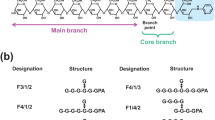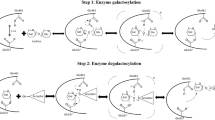Abstract
The glycosylation of ruscogenin (1) by Gliocladium deliquescens NRRL 1086 was observed and gave a regioselectively glycosylated product identified as ruscogenin 1-O-β-D-glucopyranoside (2) by infrared, mass spectrometry, and nuclear magnetic resonance spectra. Time-course studies indicated that it appeared to be favorable to accumulate 2 when ruscogenin was added to the 24-h-old stage II culture, and the yield of 2 was about 20.1% during 120∼168 h. It was noted that additional carbohydrates could significantly increase glycoside formation and the yield of 2 even reached as high as 68% compared with the control 20.1%. The primary investigation about the characteristics of the enzyme resulted that the reaction was blocked by β-glycosidase inhibitor imidazole, however, was enhanced remarkably by glycosyltransferase inhibitor sodium dodecyl sulfate. To our knowledge, this is the first reported case of producing steroidal saponin by microbial transformation, and G. deliquescens NRRL1086 would be a practical and highly efficient tool in producing natural ruscogenin monoside.




Similar content being viewed by others
References
Bouskela E, Cyrino FZ, Marcelon G (1994) Possible mechanisms for the inhibitory effect of Ruscus extract on increased microvascular permeability induced by histamine in hamster cheek pouch. J Cardiol Pharm 24:281–285
Capra C (1972) Pharmacology and toxicology of some components of Ruscus aculeatus L. Fitoterapia 43:99–113
Chang LC, Tsai TR, Wang JJ (1998) The rhamnose moiety of solamargine plays a crucial role in triggering cell death by apoptosis. Biochem Biophys Res Commun 242:21–25
Charney W, Herzog HL (1967) Microbial transformations of steroids. Academic Press, Inc., New York
Chen X, Zhang J, Liu JH, Yu BY (2008) Biotransformation of p-, m-, and o-hydroxybenzoic acids by Panax ginseng hairy root cultures. J Mol Catal, B Enzym 54:72–75
Chludil HD, Seldes AM, Maier MS (2002) Antifungal steroidal glycosides from the Patagonian starfish Anasterias minuta: structure-activity correlations. J Nat Prod 65:153–157
Cundliffee E (1992) Glycosylation of macrolide antibiotics in extracts of Streptomyces lividans. Antimicrob Agents Chemother 36:348–352
Facino RM, Carini M, Stefani R, Aldini G, Saibene L (1995) Antielastase and anti-hyaluronidase activities of saponins and sapogenins from Hedera helix, Aesculus hippocastanum and Ruscus aculetus factors contributing to their efficacy in the treatment of venous insufficiency. Arch Pharm 328:720–724
Hays WS, Vanderjagt DJ, Bose B, Serianni AS, Glew RH (1998) Catalytic mechanism and specificity for hydrolysis and transglycosylation reactions of cytosolic β-glucosidase from guinea pig liver. J Biol Chem 273:34941–34948
Hosny M, Dhar K, Rosazza JP (2001) Hydroxylations and methylations of quercetin, fisetin, and catechin by Streptomyces griseus. J Nat Prod 64:462–465
Hu K, Yao XS (2002) The cytotoxicity of protoneodioscin(NSC-698789), a furostanol saponin from the rhizomes of Dioscorea collettii var.hypoglauca, against human cancer cells in vitro. Phytomedicine 9:560–565
Ibrahim ARS, Galal AM, Mossa JS, Feraly FS (1997) Glucose-conjugation of the flavones of Psiadia Arabica by Cunninghamella elegans. Phytochem 46:1193–1195
Iizuka H, Naito A (1981) Microbial transformations of steroids and alkaloids, 2nd edn. University Park Press, Baltimore
Koeller KM, Wong CH (2000) Synthesis of complex carbohydrates and glycoconjugates: enzyme-based and programmable one-pot strategies. Chem Rev 100:4465–4493
Kou JP, Sun Y, Lin YW, Cheng ZH, Zheng W, Yu BY, Xu Q (2005) Antiinflammatory activities of aqueous extract from Radix Ophiopogon japonicus and its two constituents. Biol Pharm Bull 28:1234–1238
Kou JP, Tian YQ, Tang YK, Yan J, Yu BY (2006) Antithrombotic activities of aqueous extract from Radix Ophiopogon japonicus and its two constituents. Biol Pharm Bull 29:1267–1270
Kou JP, Ma L, Yu BY (2007) Possible mechanism of anti-adhesive activity of ruscogenin, a major sapogenin from Radix Ophiopogonis japonici. Chin J Pharmacol Toxicol 21:323–324
Lee KR, Kozukue N, Han JS (2004) Glycoalkaloids and metabolites inhibit the growth of Human Colon (HT29) and Liver (HepG2) cancer cells. J Agric Food Chem 52:2833–2389
Li W, Koike K, Asada Y, Yoshikawa T, Nikaido T (2002) Biotransformation of umbelliferone by Panax ginseng root cultures. Tetrahedron Lett 43:5633–5635
Liu MZ, Yu B, Hui HZ (1998) First Total synthesis of 25(R)-ruseogenin-l-yl[3-D-xylopyranosyl-(1 → 3)-[3-D-glucopyranosyl-(1 → 2)]-[3-D-fucopyranoside], an ophiopogonis saponin from the Tuber of Liriope muscari (Decne.). Tetrahedron Lett 39:415–418
Ma L, Kou JP, Huang Y, Yu BY (2006) Effects of ruscogenin on adhesion of HL-60 cells to ECV304 cells. Chin Pharmacol Bull 22:706–709
Mimaki Y, Nakamura O, Sashida Y (1994) Steroidal saponins from the bulbs of Lilium longiflorum and their antitumour-promoter activity. Phytochem 37:227–232
Mimaki Y, Yokosuka A, Kuroda M, Sashida Y (2001) Cytotoxic activities and structure–cytotoxic relationships of steroidal saponins. Biol Pharm Bull 24:1286–1289
Ming SK, Daniel GC, Alexander DA, Joyce CA, Coats JH, Marshall VP (1989) Microbial glycosylation of erythromycin A. Antimicrob Agents Chemother 33:2089–2091
Moalic S, Liagre B, Corbiere C (2001) A plant steroid, diosgenin, induces apoptosis, cell cycle arrest and COX activity in osteosarcoma cells. FEBS Lett 506:225–230
Myszkah BD, Najder M, Kaca W (2003) Synthesis and induction of apoptosis in B cell chronic leukemia by diosgenyl 2-amino-2-deoxy-β-D-glucopyranoside hydrochloride and its derivatives. Carbohydr Res 338:133–141
Rantwijk F, Oosterom MW, Sheldon RA (1999) Glycosidase-catalysed synthesis of alkyl glycosides. J Mol Catal, B Enzym 6:511–532
Rao KV, Weisner NT (1981) Microbial transformation of quercetin by Bacillus cereus. Appl Environ Microbiol 42:450–452
Ritchie GE, Moffatt BE, Sim RB, Morgan BP, Dwek RA, Rudd PM (2002) Glycosylation and the complement system. Chem Rev 102:305–319
Sasaki J, Mizoue K, Morimoto S, Omura S (1996) Microbial glycosylation of macrolide antibiotics by ATCC31080 and distribution of a macrolide glycosyl transferase Streptomyces hygroscopicus in several streptomyces strains. J Antibiot 49:1110–1118
Schulman M, Doherty P, Arison B (1993) Microbial conversion of avermectins by Saccharopolyspora erythraea: glycosylation at C-4′ and C-4″. Antimicrob Agents Chemother 37:1737–1741
Shibazaki M, Yamaguchi H, Sugawara T, Suzuki K, Yamamoto T (2003) Microbial glycosylation and acetylation of brefeldin A. J Biosci Bioeng 96:344–348
Smith LL (1973) Microbiological reactions with steroids. Spec. Period. Rep. Terpenoids Steroids 4:394–530
Sparg SG, Light ME, Staden J (2004) Biological activities and distribution of plant saponins. J Ethnopharmacol 94:219–243
Sun HX, Yang ZG, Ye YP (2006) Structure and biological activity of rotopanaxatriol-type saponins from the roots of Panax notoginseng. Int Immunopharmaco 6:14–25
Vilches C, Hernandez C, Mendez C, Salas JA (1992) Role of glycosylation and deglycosylation in biosynthesis of and resistance to oleandomycin in the producer organism, Streptomyces antibiotics. J Bacteriol 174:161–165
Yang G, Zhang ZM, Bai HJ (2008) Biotransformation of β-amyrin acetate by Rhodobacter sphaeroides. J Biosci Bioeng 105:558–561
Yuan YJ, Ge ZQ (2004) Plant cell culture engineering. Chemical Industry Press, Beijing
Zhang XF, Cui Y, Huang JJ (2007) Immuno-stimulating properties of diosgenyl saponins isolated from Paris polyphylla. Bioorg Med Chem Lett 17:2408–2413
Acknowledgment
This work was supported by the National Nature Science Foundation of China (NSFC No. 20602040, 30672603). Thanks also give to the financial support from the State Administration of Foreign Expert Affairs of China (no. 111-2-07) and the “111 Project” from the Ministry of Education of China.
Author information
Authors and Affiliations
Corresponding authors
Rights and permissions
About this article
Cite this article
Chen, ND., Zhang, J., Liu, JH. et al. Microbial conversion of ruscogenin by Gliocladium deliquescens NRRL1086: glycosylation at C-1. Appl Microbiol Biotechnol 86, 491–497 (2010). https://doi.org/10.1007/s00253-009-2315-y
Received:
Revised:
Accepted:
Published:
Issue Date:
DOI: https://doi.org/10.1007/s00253-009-2315-y




